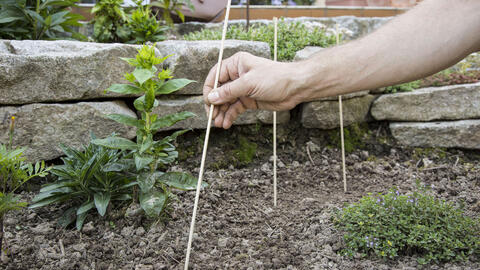5 Plants to Sow in August
If you want to enjoy magnificent flowers next year, it’s time to start sowing seeds. We introduce 5 plants that you can sow in August.

It is a good idea to label the areas where you sow biennials
Despite the summer heat, there are a few plants that you can still sow in August. This particularly includes biennials which only tend to form roots and leaves the year after sowing and then flower the following year. By sowing seeds in August, you can ensure flowering the year after next. And: With favorable climatic conditions and early sowing, there is a good chance that these biennials will even flower in the first year. We’ve selected five plants that will add some color to your flower beds over the coming years.
It’s important to water seeds well after sowing. You should also make sure that the soil does not dry out in the first few weeks as the seeds need moisture to germinate.
The genus Hollyhocks (Alcea) comprises about 60 species. The Common Hollyhock (Alcea rosea) is certainly one of the most popular species, many people simply know it as hollyhock. With exceptionally tall growth of up to 6.5 feet and palm-sized flowers, they’re a firm favorite in any romantic cottage or country house garden. Hollyhocks can be easily sown directly into flower beds. Leave a distance of approximately 16 inches between plants. Sow in a sunny location in nutrient-rich, well-drained, and dry to slightly moist soil. It is important to loosen the soil before sowing as Hollyhocks develop taproots, and this makes it easier for them to penetrate the soil. Hollyhocks look particularly nice when sown in front of walls, along fences, or against light house walls. If the seeds were sown too densely, it is a good idea to separate the seedlings early enough so that the giant plants have sufficient space to realize their full potential.

Wildlife gardens are in fashion: If you want to do something nice for the insect world, August is a good time to sow Wild Carrots. The native wild and medicinal plant is particularly popular with insects. Whether it’s beetles, flies, or wild bees – insects are magically attracted to the umbellifer. But it’s not only the insect world that appreciates the natural beauty. Combined with ornamental grasses, coneflowers, or thistles, the wild herbaceous plant exudes a natural charm. The best time to sow Wild Carrots is towards the end of August. Choose a sunny location with nutrient-rich, calcareous, and permeable soil.
Horned violet can be sown directly into flower beds until the end of September. Plants in the family Violaceae thrive both in sunny and partially shaded locations. The soil should be loose, humus-rich, and moist. Horned violet tends to run to seed if it feels very happy in its location. It can be grown in pots in humus-rich balcony potting soil or permeable garden soil. Small tip: Mix a little compost and horn meal into the substrate to get the young plants off to a good start.

With its small dark red flower heads, is a real eye-catcher in the garden and goes particularly well with wild perennials and ornamental grasses. Great Burnet is also an option for attractive shrub beds. It is important to take the location requirements into account when sowing outdoors. The delicate herbaceous perennial prefers nutrient-rich, moist, but permeable soil, and a sunny to partially shaded location. If great burnet is too dry, it can become infested with powdery mildew.
Friends of insects appreciate the flowers of the Common Evening Primrose (Oenothera biennis) as the enchanting fragrance of the herbaceous plant attracts many insects, such as moths, every evening. The Evening Primrose prefers a sunny location, and sandy-loamy but permeable soils. The seeds should be sown at a depth of around 0.79 inches and separated after around three to four weeks. Small tip: As the Evening Primrose tends to self-seed, you should cut off the inflorescences in good time if self-sowing is not desired.



